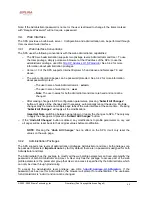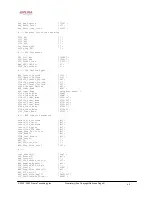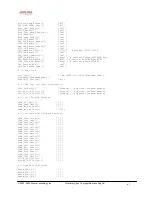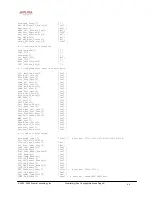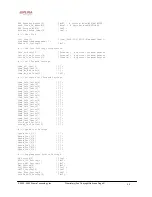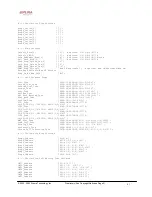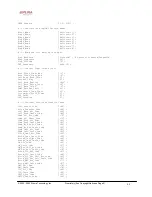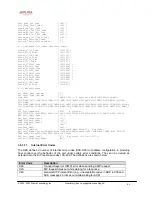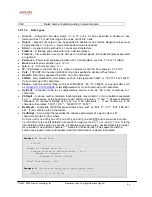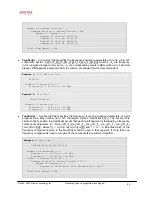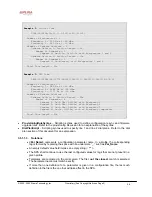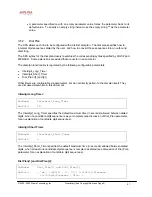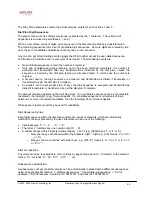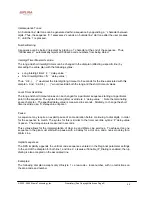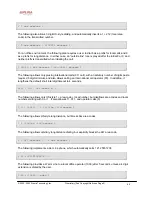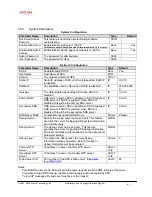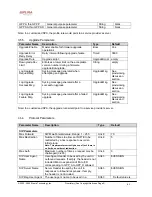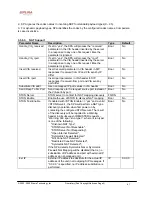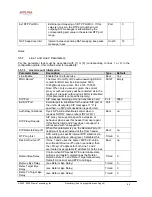
© 2003 - 2005 Sipura Technology, Inc
Proprietary (See Copyright Notice on Page 2)
54
X60
Dialed number invalid according to given dial plan
3.5.1.1.2. Data
Types
•
Uns<n>
– Unsigned n-bit value, where n = 8, 16, or 32. It can be specified in decimal or hex
format such as 12 or 0x18 as long as the value can fit into n bits.
•
Sig<n>
– Signed n-bit value. It can be specified in decimal or hex format. Negative values must
be preceded by a “-“ sign. A ‘+’ sign before positive value is optional
•
Str<n>
– A generic string with up to n non-reserved characters.
•
Float<n>
– A floating point value with up to n decimal places.
•
Time<n>
– Time duration in seconds, with up to n decimal places. Extra decimal places specified
are ignored.
•
PwrLevel
– Power level expressed in dBm with 1 decimal place, such as –13.5 or 1.5 (dBm)
•
Bool
: Boolean value of either “yes” or “no”
•
{a,b,c,…}
– A choice among a, b, c, …
•
IP
– IP Address in the form of x.x.x.x, where x between 0 and 255. For example 10.1.2.100
•
Port
– TCP/UDP Port number (0-65535). It can be specified in decimal of hex format.
•
UserID
– User ID as appeared in a URL; up to 63 characters
•
FQDN
– Fully Qualified Domain Name, such as “sip.sipura.com:5060”, or “109.12.14.12:12345”.
It can contain up to 63 characters
•
Phone
– A phone number string, such as 14081234567, *69, *72, 345678, or a generic URL such
as
1234@10.10.10.100:5068
, or jsmith@sipura.com. It can contain up to 39 characters.
•
ActCode
– Activation code for a supplementary service, such as *69. It can contain up to 7
characters.
•
PhTmplt
– A phone number template. Each template may contain 1 or more patterns separated
by a “,”. White space at the beginning of each pattern is ignored. “?” and “*” represent wildcard
characters. To represent literally use %xx; e.g, %2a represents *. It can contain up to 39
characters. Examples: “1408*, 1510*”, “1408123????, 555?1”.
•
RscTmplt
– A template of SIP Response Status Code, such as “404, 5*”, “61?”, “407, 408, 487,
481”. It can contain up to 39 characters.
•
CadScript
– A mini-script that specifies the cadence parameters of a signal. Up to 127
characters. Syntax: S
1
[;S
2
], where
S
i
=D
i
(on
i,1
/off
i,1
[,on
i,2
/off
i,2
[,on
i,3
/off
i,3
[,on
i,4
/off
i,4
[,on
i,5
/off
i,5
[,on
i,6
/off
i,6
]]]]]) and is known as a
section
,
on
i,j
and off
i,j
are the on/off duration in seconds of a
segment
and i = 1 or 2, and j = 1 to 6. D
i
is the
total duration of the section in seconds. All durations can have up to 3 decimal places to provide 1
ms resolution. The wildcard character “*” stands for infinite duration. The segments within a
section are played in order and repeated until the total duration is played. Examples:
Example 1
: Normal Ring
60(2/4)
Number of Cadence Sections = 1
Cadence Section 1: Section Length = 60 s
Number of Segments = 1
Segment 1: On=2s, Off=4s
Total Ring Length = 60s
Example 2
: Distinctive Ring (short,short,short,long)
60(.2/.2,.2/.2,.2/.2,1/4)

